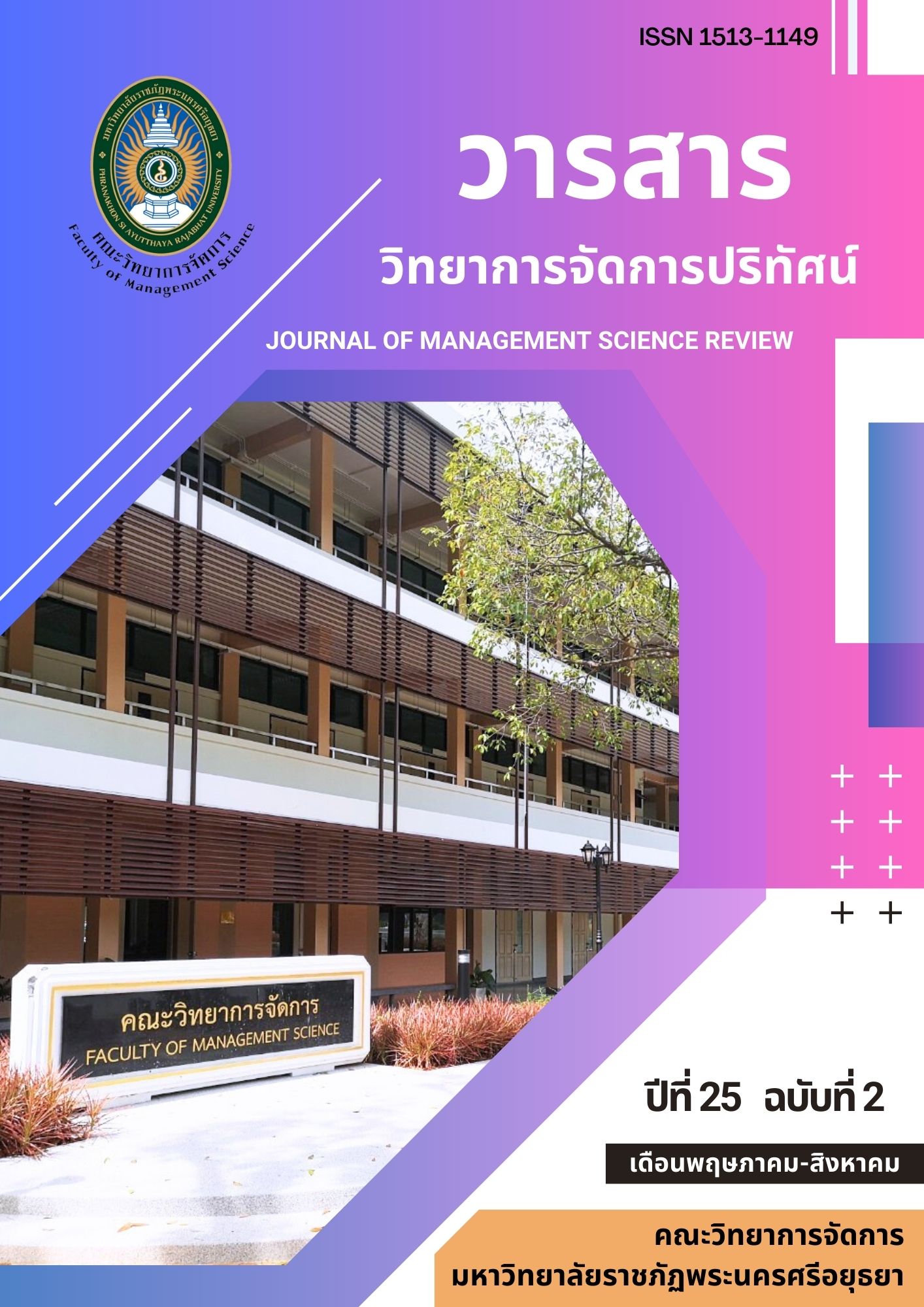Warehouse Efficiency Optimization Using Fastest Turning Closest to the Door Method A Case Study: A company in the personal security equipment industry
Keywords:
Fastest Turning Closest to the Door Method, Warehouse Management, InventoryAbstract
The purposes of this research were 1) to study and analyze the work processes in the warehouse, and 2) to study the efficiency of warehouse management in terms of reducing product search time and picking distance. The quantitative data was gathered on historical inventory movement within the warehouse over two years (2022–2023). By studying the root causes of existing challenges and proposing effective solutions, the research identifies issues arising from an unclear storage layout, resulting in item congestion, extended search and retrieval times, and increased picking errors. To address these challenges, the researchers propose a solution involving the implementation of ABC analysis-based inventory categorization, grouping items based on their movement patterns. Furthermore, the "Fastest Turning Closest to the Door Method" is employed, positioning frequently accessed items near the entrance.
Findings from the study revealed that after implementing the ABC analysis-based categorization and rearrangement strategy, the inventory items were grouped as follows: Group A (11 items, 42 boxes), Group B (20 items, 45 boxes), and Group C (217 items, 245 boxes). The "Fastest Turning Closest to the Door Method" was then tested, showing significant efficiency improvements. Before the changes, the average monthly time spent searching for items was 599.14 hours, and the average monthly distance traveled for item retrieval was 2,155,481 meters. After the changes, these figures were reduced to 451.51 hours (a 24.64% improvement) and 1,672,249 meters (a 22.42% improvement), respectively. These results demonstrated that the proposed new inventory storage format effectively enhanced operational efficiency.
References
ขวัญวรา หอมทรัพย์. (2560). การประยุกต์ใช้ Linear Programming สำหรับการวางแผนจัดการวัตถุดิบ สำหรับธุรกิจเฟอร์นิเจอร์ขนาดย่อม. วิทยานิพนธ์บริหารธุรกิจมหาบัณฑิต มหาวิทยาลัยธรรมศาสตร์.
เจนรตชา แสงจันทร์. (2562). การเพิ่มประสิทธิภาพการจัดการคลังสินค้าโดยการประยุกต์ใช้วิธีการจัดแบ่งวัสดุตามความถี่ในการใช้ กรณีศึกษา บริษัทแห่งหนึ่งในอุตสาหกรรมการพิมพ์. วิทยานิพนธ์บริหารธุรกิจมหาบัณฑิต สาขาวิชาการจัดการโลจิสติกส์, มหาวิทยาลัยเทคโนโลยีราชมงคลธัญบุรี.
ธิญาดา ใจใหมคร้าม. (2558). การเพิ่มประสิทธิภาพการจัดการคลังสินค้า กรณีศึกษา คลังสินค้า 2 ราษฎร์บูรณะ กรุงเทพมหานคร องค์การคลังสินค้า. วิทยานิพนธ์บริหารธุรกิจมหาบัณฑิต มหาวิทยาลัยกรุงเทพ.
นฤทธิ์ เกิดวิเมลือง และ เชฐธิดา กุศลาไสยนนท์. (2559). แนวทางการจัดการคลังสินค้าอิเล็กทรอนิกส์ที่มีผลต่อการดำเนินงานเพื่อรองรับการเข้าสู่ประชาคมอาเซียนของอุตสาหกรรมโรงสีข้าวไทย. (รายงานการวิจัย). กรุงเทพฯ: มหาวิทยาลัยเทคโนโลยีรัตนโกสินทร์.
นพรัตน์ งึดสันเทียะ. (2563). การปรับปรุงแผนผังจัดเก็บวัตถุดิบ กรณีศึกษา โรงงานอิเล็กทรอนิกส์. วิทยานิพนธ์วิศวกรรมศาสตรมหาบัณฑิต มหาวิยาลัยธรรมศาสตร์.
นราวิชญ์ มงคลรัชดารมย์. (2559). การเพิ่มประสิทธิภาพการจัดการสินค้าคงคลัง กรณีศึกษาบริษัท B ซัพพลายเชน จำกัด. วิทยานิพนธ์บริหารธุรกิจมหาบัณฑิต มหาวิทยาลัยหอการค้าไทย.
นิธิศ ปุณธนกรภัทร์ ปัญญา สำราญหันต์ และคณะ. (2565, มกราคม - มิถุนายน). การพัฒนาระบบคลังสินค้าวัตถุดิบ กรณีศึกษา โรงงานผลิตเสื้อผ้ากีฬา. วารสารก้าวทันโลกวิทยาศาสตร์, 22(1), 156-172.
ปฐมพงษ์ หอมศรี และ จักรพันธ์ คงธนะ. (2557, กรกฎาคม – ธันวาคม). การพัฒนาระบบการจัดการสินค้าคงคลัง กรณีศึกษาบริษัท ติดตั้งและบำรุงรักษาเครื่องจักรของโรงงาน. SME วารสารวิชาการคณะเทคโนโลยีอุตสาหกรรม, 7(2), 42-56.
พงษ์ชัย อธิคมรัตนกุล. (2554). เอกสารประกอบการเรียนวิชาการจัดการคลังสินค้า (Warehouse Management). กรุงเทพฯ: มหาวิทยาลัยเทคโนโลยีพระจอมเกล้าธนบุรี.
เมธินี ศรีกาญจน์ และ ชุมพล มณฑาทิพย์กุล. (2555, กันยายน-ธันวาคม). การปรับปรุงประสิทธิภาพตำแหน่งการจัดวางสินค้าในคลัง กรณีศึกษา บริษัท ศรีไทยซุปเปอร์แวร์ จำกัด (มหาชน) สาขาสุขสวัสดิ์. WMS Journal of Management, 2(3), 8-20.
วรรณวิภา ชื่นเพ็ชร. (2560). การวางผังคลังสินค้าสำเร็จรูปด้วยเทคนิค ABC ANALYSIS กรณีศึกษา บริษัท AAA จำกัด. วิทยานิพนธ์วิทยาศาสตรมหาบัณฑิต สาขาวิชาการจัดการโลจิสติกส์และโซ่อุปทาน วิทยาลัยโลจิสติกส์และซัพพลายเชน, มหาวิทยาลัยศรีปทุม.
สมใจ ลักษณะ. (2552). การพัฒนาประสิทธิภาพในการทำงาน. กรุงเทพฯ: มหาวิทยาลัยราชภัฏสวนสุนันทา.
อภิศักดิ์ วงศ์สนิท. (2563). การจัดการคลังสินค้าเพื่อเพิ่มประสิทธิภาพการจัดเก็บสินค้า. วิทยานิพนธ์บริหารธุรกิจมหาบัณฑิต มหาวิทยาลัยธุรกิจบัณฑิต.
Tompkins, J. A., & Smith, J. D. (1998). The Warehouse Management Handbook. (2nd ed). Raleigh, NC: Tompkins.
Jenkins, G. M., & Watts, D. G. (1968). Spectral Analysis and Its Applications Holden-Day. San Francisco.
Goetschalckx, M. (2003). Supply Chain Engineering. International Series in Operations Research & Management Science. Atlanta, Georgia.
Smith, J.D. (1988). The warehouse management handbook. New York: McGraw- Hill.
Stock, J.R., & Lambert, D.M. (2001). Strategic Logistics Management. (4th Ed). New York: McGraw Hill.




